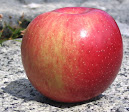Walk into any mainstream supermarket in the United States and you won't find this:

|
| A stack of Golden Russet apples for sale at a supermarket in Montreal late last year. |
But russet apples are delicious, and mainstream-popular in other countries.
To be sure, you can sometimes find russets in food coops and specialty stores. But your best bets are orchards, farm stands, and farmers markets, and in-season only.
Retailers and growers will say that consumers think apples are "supposed" to be red and won't buy anything else.

|

|
But tastes change: isn't the flesh of an apple "supposed" to be white? Yet growers and retailers are hyping the latest generation of red-fleshed apples.

|
| Lucy Rose is one of a new generation of red-fleshed apples. |
And of course consumers don't blink at the russet on a Bosc pear. If you like Boscs, you seek out the russet. The distinctive look is part of the brand.
The truth is that while growers may have to follow the market, consumers are taste-takers, not taste-makers. They choose from the choices in front of them.
Meanwhile...
In Montreal, just stroll into any grocer for some Golden Russet alongside the McIntosh and the Asian pear.

|
| Pommes Racettes à vendre à Montréal. |
It is a shame that our economic system cannot manage to deliver these goodies more easily.


I was in the Okanagan for a few days this fall, right at the time when the farmers markets were shutting down for the season. They were selling organic apples, all varieties, for just about 50 cents/lb. I bought a few Aurora apples that were left in one of the bins. I was interested because of their deep, rich, yellow hue, and I had not heard of them before. I'm always trying new kinds of fruits and vegetables, and I'm glad I did. They were the best tasting apples that I have bought in Canada. On the way home I stopped by again and bought another 10 lbs, which was pretty much all that was left at that point! This fall I'm making another trip for about 30 lbs - those Auroras make fantastic apple sauce, too. All we get in our grocery stores are the same 12 varieties. It's become incredibly boring, and expensive!
ReplyDeleteI'll bet those 12 varieties are mostly pretty similar, too!
DeleteI had a friend who did a stint in management consulting. He worked in packaged foods. The big lesson, he told me, was that by far the easiest way to get a sales lift was novelty, thus the endless stream of weird flavors of Cheetos. And yet somehow that basic lesson doesn’t get applied to fruit.
ReplyDeleteI think this interesting take is largely true, but there are some exceptions. When I was growing up there were no clementines or pluots, for instance. For apples, there has recently been tiny Rockit and a slew of red-fleshed apples.
DeleteStill most of the new varieties are a parade of minor variations from Fuji and Honeycrisp.
Every year when I go to the farmers markets, it's the russeted apples I'm looking for. Golden Russets are good, and my favorites are Ashmead's Kernel and Hudson Golden Gem. I like Bosc pears, too, so that comment was interesting.
ReplyDeleteI suspect that what we need to get russeted apples into stores is a marketing organization for them.
Yes exactly! Take some of the marketing mojo that came up with "Sweet Cheeks," (rebranded as "Wild Twist" for perhaps obvious reasons) and similar nonsense and pitch those suave, suede, sophisticated russets.
DeleteAs far as I understand it, the modern apple breeders have used to perceive the russeting as a bug, not a feature...
ReplyDeleteHence, the new sports of heritage apples usually get redder and smoother.
(Meanwhile, the pears look somewhat more conservative, for unknown reasons).
Well it may be an outlier, but the Herefordshire Russet is pretty recent.
DeleteSomething like that: Herefordshire Russet is a modern British variety (and somewhat rare one).
DeleteReminds me of a kids book
ReplyDeleteWhich one?
DeleteGood morning!
ReplyDeleteAlas, this isn't so much about the constraints capitalism inflicts on apple choice - though I do agree, and find it interesting - but I wanted to contribute some more far-reaching feedback. My partner and I recently found your blog whilst poking about the internet for apple information and reading through it together has been a real delight. Thanks for all your years of work, and the joy it's brought us!
Thank you! I regret not providing a complete Marxist critique, but am pleased when people tell me they enjoy the blog.
DeleteLove to see the russet appreciation! I'm trying to breed some red fleshed russets up here in Niagara Ontario.. tasted my first Roxbury Russet here this year and it might've been better than our golden russets .. but I'm growing out a bunch of russet seeds and making as many directed crosses moving forward as possible! LETS GROW!
ReplyDeleteRed-fleshed russet—what an audacious idea! Just picturing the visual contrast between peel and flesh.
DeleteI actually prefer Golden to Roxbury, all else equal, but they are very close.